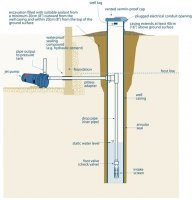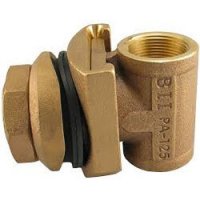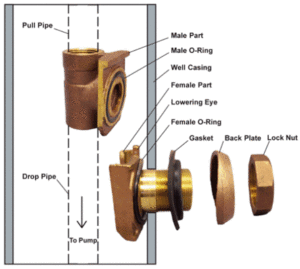Castle Rock
New Member
New guy here but have been searching this site for answers for a while. I have a vacation cabin in Wisconsin with a shallow depth well. I have a Goulds J5S pump in the crawlspace . Suction side runs horizontal out the foundation to a 3-4” capped casing and I assume uses a pitless adapter. Water table is about 20 feet below surface in a very sandy soil and I believe the point is around 30-35ft down. The well itself was installed in the mid 70’s. My pump builds pressure but takes about 5 minutes to satisfy my pressure switch on first startup for the past 2 years (I shut it down when I leave) It holds pressure just fine and the pressure at the tap is normal until it runs low enough to start pump. It take a long time to recover. Its getting worse now and when I take a shower the pumpwill run constant and the pressure drops low enough to not get much water out of the shower. Filling the washer takes 10-15 minutes so I am not getting much volume. It will eventually shut off and hold pressure indefinitely. When pump runs I can hear air in the pump housing. Im thinking its leaking at either the union on the suction side or the pitless adapter or a clogged point.
I took the cap off the outside casing and there is a threaded rod which is probably for lifting. I have searched for what this well could look like but cant seem to find anything that looks like what I am looking at !! Im pretty sure it is a driven well since the water table is so high and its relatively sandy with a layer of hard pan at about 15 ft. . Will I be able to put some Nuwell down the outer casing to see if its a screen problemt that can be cleared ? If its not the screen then I will have to probably dig to see if its the horizontal galvanized pipe . Any input appreciated. Im having a hard time figuring out what is inside that casing and what I would be pulling out of it !
I took the cap off the outside casing and there is a threaded rod which is probably for lifting. I have searched for what this well could look like but cant seem to find anything that looks like what I am looking at !! Im pretty sure it is a driven well since the water table is so high and its relatively sandy with a layer of hard pan at about 15 ft. . Will I be able to put some Nuwell down the outer casing to see if its a screen problemt that can be cleared ? If its not the screen then I will have to probably dig to see if its the horizontal galvanized pipe . Any input appreciated. Im having a hard time figuring out what is inside that casing and what I would be pulling out of it !



